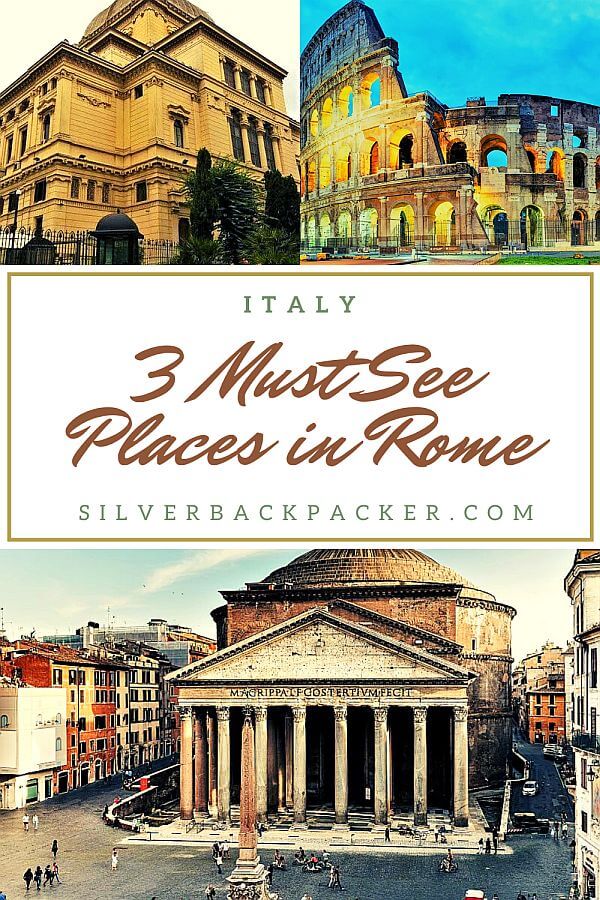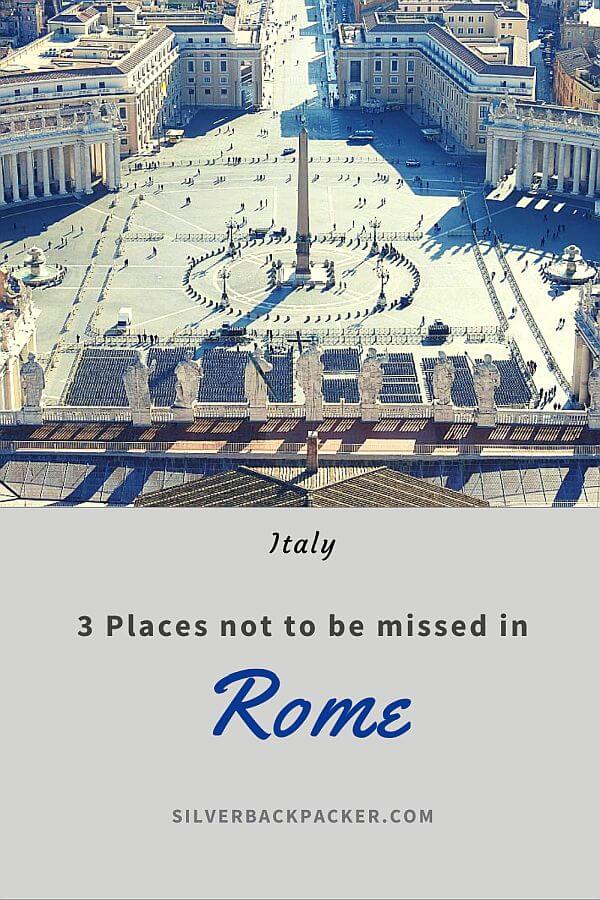3 Places not to be missed in Rome, Italy
The Pantheon of Agrippa
The Colosseum
The Jewish Ghetto
Rome – The Eternal City
Rome is one of the most popular Europe’s most popular tourist destinations. Rome has a rich history and is also known as the Eternal City. At the height of the Roman Empire this city ruled the known world and it was thought that Rome would last forever and if its days were numbered then it would also mean the end of the world, hence Eternal.
With so much to see and do what stands out as the must see places?? I have chosen three historical places to add to your list. Have a read and let us know in the comments below what else you would add to this agenda of Places in Rome.

Pantheon of Agrippa
Rome is the city with the greatest amount of historical assets from all over the world. To set foot in the Italian capital is to travel to the past, to enjoy the culture at the foot of the street and to transport yourself to a very interesting time.
Every corner of this city reminds us that we are facing one of the most historically important cities in the world. Rome was once the capital of the world, the nerve center of an empire that spanned three continents. It is also the city where artists of great historical prestige have passed. It is the city of squares, bridges, buildings and monuments that have left many travelers with their mouths open over the years.
Rome is culture, art and history. If you travel to the Italian capital there are a number of things you can not miss. You should visit the Colosseum, the Vatican, the Basilica of San Pietro, the Sistine Chapel, the Trevi Fountain, the Piazza Nova or the Spanish Steps. Now, there is a monument that from an architectural point of view you can not miss the day you visit this Italian city. It is the Pantheon of Agrippa, a temple dedicated to all the gods.
It was built between 118 and 125 AD, during the glory period of the High Roman Empire, and it was the Emperor Hadrian who ordered its construction. The importance of this monument comes not only because it is one of the most beautiful buildings in the world and one of the best preserved of all Rome, but above all because it is a real engineering work – especially if we travel in time and are aware of the moment in which it was built.
What makes the Pantheon extraordinary and distinguishes it as one of the buildings best preserved until now is precisely its shape. The Pantheon has an access colonnade, an intermediate connecting body and a large circular nave. On this ship a hemispherical dome rises on a cylindrical drum that makes of ceiling. What distinguishes the Pantheon from other previous constructions that also used the domes, is that it is the first temple with this form. In addition its dimensions are extraordinary: one could half field of soccer in the floor and another half standing.
In addition to being built with perfect precision that surprises at that time the material used and the entire construction system employed is what has made this building of incredible dimensions has been preserved so well. In fact it has been able to survive 20 centuries without hardly suffering major damage.
In addition to its construction, everything in the Pantheon has a symbolic meaning, starting with the enormous oculus in the center of the dome, an opening of nine meters in diameter that lets in sunlight and gives the place an almost unreal and extraordinary atmosphere . So much so that this is one of the must visits if you travel to Rome. Only by seeing you can understand the importance of this monument.

The Colosseum
After wandering around enjoying the tons of ruins that sit side by side with modern Rome, we finally found the gorgeous Colosseum – probably the sight that best defines Rome, and one of my top bucket list destinations.
Construction of the Colosseum began somewhere around 70 A.D, so you can forgive the scaffolding that’s up on a lot of the inner and outer arenas as they restore it. It’s had a pretty rough time through earthquakes and general wear through the centuries, but it still looks stunning for its age!
There was an ever-increasing queue to enter into the inner arena, but we expected nothing less – we were quickly learning just how popular Rome is with tourists. Expect to queue everywhere!
Top tip: Don’t bother going with any of the ‘guides’ that circle the queue like hungry sharks around a surfer, offering “queue jump” if you pay them an additional 25 Euro on top of your admission fee. The prospect was pretty tempting when we were waiting out in the baking heat, but the line moved surprisingly quickly – only to disappointingly realise that passing through the entrance wasn’t where you bought your tickets – the line continued on considerably inside the outer wall.
Still, when we saw the so-called “queue jump” option being carried out we were glad to wait – the guides just walk you up to near the front of the queue and push you in, then pretty much abandon you to wait in amongst the annoyed queue-ers! There are official tours you can join from your hotel that actually do have an official queue jump bonus, but otherwise the tours are ‘illegal.’
The whole queuing experience was completely unorganised for an attraction that must always be overrun with tourists, but as soon as we had our tickets we forgot all that as we finally got to step inside the Colosseum. However many centuries on, it still has an amazing atmosphere, and I’m sure everyone’s imagination runs as mine did, back to what it must have been like in its heyday.
The Colosseum was used for public spectacles – with hunting, re-enactment of myths and other entertainment before the big gladiatorial events in the afternoon. The hunts often featured ‘sets’ with foliage and other things to hide behind, and animals imported from Africa and the Middle East. The Colosseum could hold 50,000 people and you were seated amongst your class, so it was a community event on a huge scale!
The arena was also used for executions so the amount of bloodshed in the world’s biggest amphitheatre is unimaginable – for the same species we lived unrecognisable lives!
Despite being packed with people, the Colosseum was amazing and surpassed all expectations.

Rome’s Jewish Ghetto
We learned so much from Francesca on our tour around Rome’s amazing historical places, particularly in the Jewish Ghetto…this gave us a whole new perspective on this area of the city.
Way back in 1550, the Pope ordered the 2,000 Jewish Romans into segregation in a small area of the city – that would become known as the Jewish Ghetto. Some Jews initially thought this segregation would be good for their community; keeping them protected from Christian attacks, but all their basic human rights were taken from them as part of their segregation. They were even forced to pay for the wall that was built to keep them confined in the Ghetto. Jews weren’t permitted to own property, even within the Ghetto, and what they could do to earn a living was controlled by the Christian population.
Located right by the river, the Jewish Ghetto was constantly flooding, forcing the inhabitants to get around using boats. Initially, there was only one gate, but as the population grew to 5,000, another few were added, but still these were only opened for an hour each night to allow the Jews to collect water from the fountain. The fountain was renovated by the aristocratic family whose house looked over it, so they would have something more ‘pleasing’ to look at – charming.
Though the population of the Jewish Ghetto had grown considerably over a century, the area was not allowed to expand outwards to accommodate the increase in inhabitants, so the Jewish had to build upwards. Although they created more living space, they also blocked out much of the light, creating dank conditions in their confines – which became all the worse when the plague came in the 1650’s, wiping out a quarter of their population.
Through the centuries, the Jewish Ghetto was abolished and reinstated many times under different rulers and laws. Unfortunately for the Jewish population in Rome, theirs was the last Ghetto left in Europe, with abolition in 1888 meaning they could live freely again. Only a few short decades later, in the 1930’s, the Jewish Ghetto was reinstated by the Nazis, and their treatment became even worse than ever before. In one night, 1,700 Jews were captured and taken to Auschwitz, never to be seen again.
Along the front of the Ghetto, the original houses were destroyed when the Jews became free, making way for the road that now runs between there and the river. Toward the back of the Ghetto though, the original houses still remain, renovated into new apartments now, but still the memory of past suffering is honoured – look out for gold plaques on the floor outside entrances to the buildings. The names remain in memory of lives lost.
The original synagogue remains in what was the Jewish Ghetto, untouched by the Nazis who thought it was a church and therefore under the protection of the Vatican – a resolute symbol of the end of Jewish suppression.
Now, what was the Jewish Ghetto has an awesome community feel about it, with great restaurants and a buzz of activity in the evening – but always great to appreciate the epic history of such a place.

Essential Travel Guides
3 Places not to be missed
in
Rome, Italy
Related Posts you may like to read
How To Live Like A Local In Corfu, Greece
Please Note – All blog post photos on Silverbackbacker.com are of a lower quality to enable faster loading and save you data. If you would like to buy or license higher quality copies of any of the photographs you can email us at silverbackpackertravels@gmail.com
All photographs and content on this website remain the property of Silverbackpacker.com. Images may not be downloaded, copied, reproduced or used in any way without prior written consent.
Print purchases entitle the purchaser to the ownership of the image but not to the copyrights of the image which still remain with Silverbackpacker.com even after purchase.
Follow Silverbackpacker for more of his Travels
Facebook @silverbackpacker | Instagram @silverbackpacker
Twitter @silverbackpaker | Pinterest @silverbackpaker
Audere Est Facere – Silverbackpacker.com – To Dare is To Do
Affiliate Disclaimer: Links on this website may be affiliate links that could result in us receiving compensation when you purchase a product or service from that link. You do not pay any extra fees for these items. This helps us to keep this website going. Thank you for your support.
Disclaimer | Privacy Policy | Cookie Statement © All Rights Reserved



